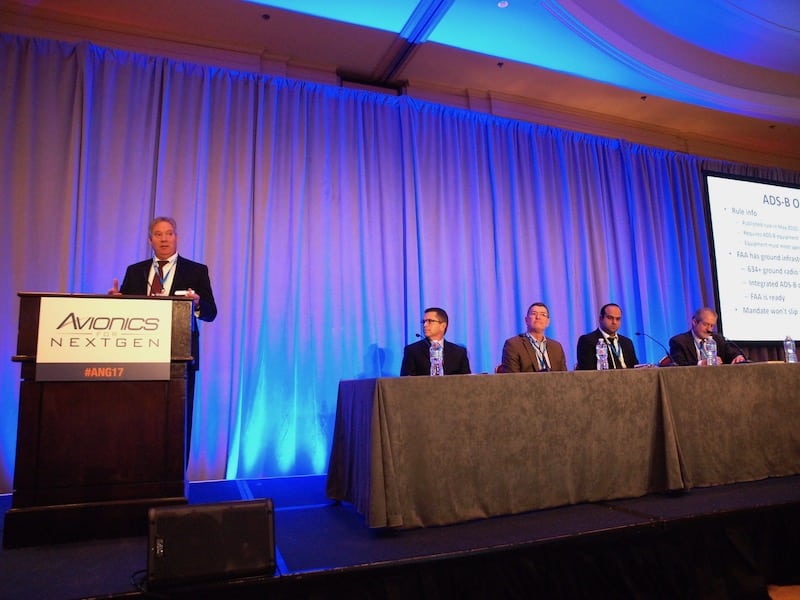
FAA’s James Marks takes the lectern during Avionics for NextGen 2017 Nov. 15. The panel also includes Becker Avionics’ Hal Adams (far right), Gables Engineering’s Charlie Bibb (left center) and Allegiant Air’s Ankit Nanda (right center), moderated by Mitre’s Sean McCourt (second from left). Photo by Vince Lim
If the FAA has said it once, the FAA has said it a million times: The ADS-B Out mandate deadline will not slip. After Jan. 1, 2020, all U.S. airspace in which a Mode S transponder is currently required will be restricted to aircraft with ADS-B Out technology. Even airliners, which have an exemption, must comply — and it may not be well understood.
“I get the feeling that people are misinterpreting what the exemption actually allows,” James Marks, ADS-B focus team lead for the FAA, said during a panel at Avionics for NextGen. “It does not exempt you from equipping with ADS-B.”
It may seem like the FAA’s exemption, Exemption 12555, gives airlines an extra five years to equip with ADS-B Out. That, however, is not the case.
“All the exemption does is buy you five more years to replace those old positioning sources with one of the new positioning sources,” Marks said. “You still have to have an ADS-B Out system come 2020.”
If the exemption is granted by the FAA, the operator may use first- and second-generation GPS receivers, considered as selective availability (SA) unaware/on and SA aware, until 2025. It is a product of Equip 2020, as the group evaluated barriers to ADS-B Out equipage. Marks explained that due to the mixture of developing technology, international standards and technology facing the air carriers, an exemption of this type made sense.
“The overarching discussion when we started Equip 2020 was, ‘Hey, we have all this cool stuff coming … but it’s not coming until after 2020,’” Marks said.
Current ADS-B Out technology isn’t perfect. Some who have already installed the equipment have been faced with technical difficulties. Nonperforming equipment (NPE) was another topic discussed at length during the panel at Avionics’ annual event. At one point last year, Marks said, the amount of aircraft faced with NPE was greater than the amount with equipment functioning correctly. Since January, that number has come back down.
One of the most frequent causes of NPE, he continued, is an incorrect identification number. This is usually human error, with some typing in wrong characters or forgetting to change the number aircraft to aircraft when working on a fleet. Sometimes, aircraft start operating after an installation with a factory default code. Instead of a 24-bit ICAO aircraft address, a factory code is usually generic: 000000, 000001, FFFFFF and others. In July, Marks explained during a webinar that this could lead to hazardous conditions if aircraft operate with the same factory default code.
“That becomes a concern when we have two aircraft transmitting the same data flying near one another or within the same ATC,” Marks said. “The ground automation system can’t distinguish between those two aircraft, which presents a problem to controllers.”
Marks said the FAA is pushing GA and experimental shops doing self installs to find errors themselves before the agency has to get involved. One available resource he suggested is the FAA’s Public ADS-B Performance Report. It not only saves the time and money it would take to fix an error or reinstall the equipment, but it also saves resources for the FAA.
“We spend about 2.5 man hours mitigating one NPE. So we have 6,000 [NPEs] and eight guys [to deal with them],” Marks told the Avionics for NextGen attendees. “It doesn’t take a math major to figure out that we’ve got a lot of work to do over the next two years.”
There is a requirement for a fail indicator that will alert pilots during operation. Gables Engineering’s VP for sales and support, Charlie Bibb, also an ADS-B Out panelist, clarified exactly what the associated advisory circular outlined.
“Just to clarify, there’s no requirement to annunciate an ADS-B failure in the flight deck. What the advisory says is that you need to be able to distinguish the difference between transponder failure and an ADS-B failure,” Bibb said. “The circular also states that the existing ATC functions … remain unchanged, and they reside today on the ATC or the transponder control panel.”
What also was resident on the control panel is the transponder fail indication.
“So now we have this opportunity to distinguish between a hardware equipment failure with the transponder and an ADS-B function failure, which typically means temporary loss of your position,” he explained.
If there is a failure and the FAA gets involved, a new agency culture promotes a non-disciplinary attitude.
“I tell my guys when you call … assume that they have no idea that this problem even exists,” Marks said. “So to us, it sort of embraces our new compliance philosophy within Flight Standards. We’re not here to punish; we’re here to tell you, ‘You have a problem and we’re here to help you solve it.’”